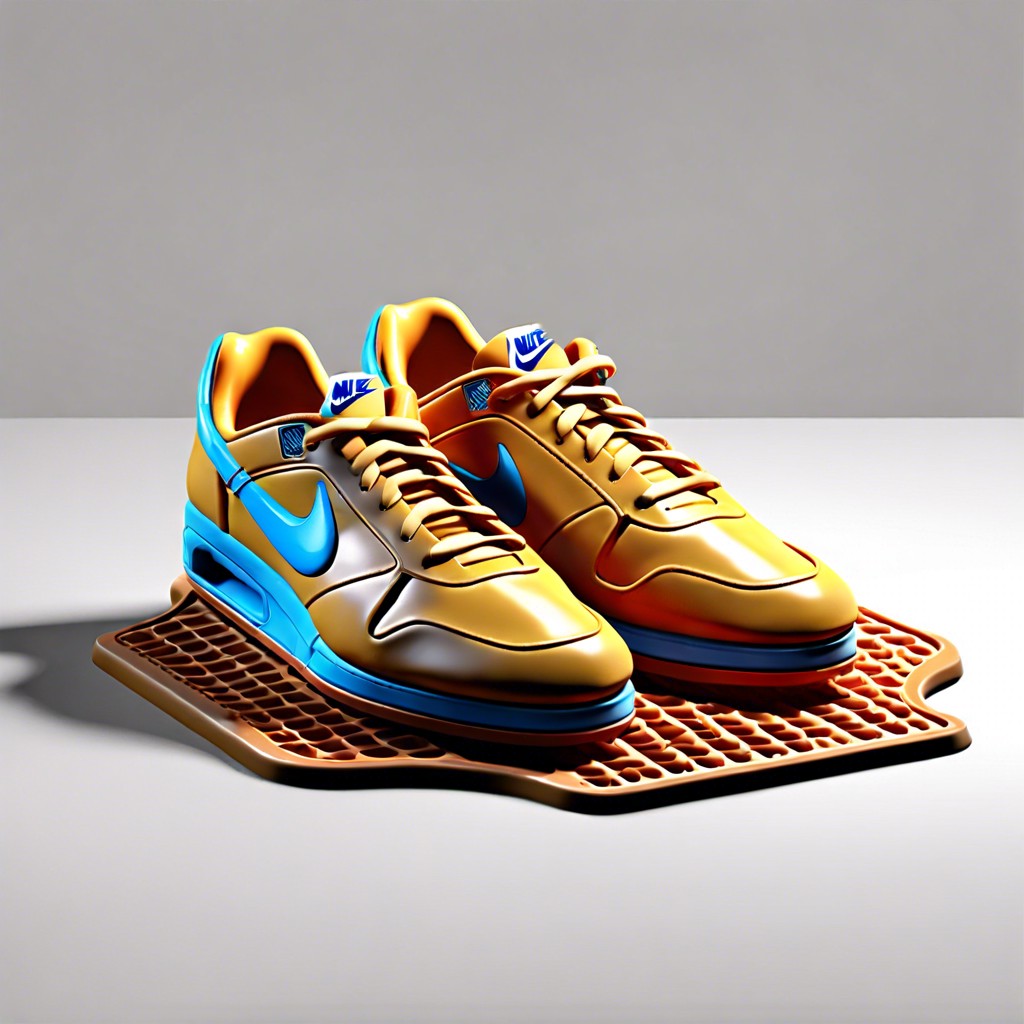Last updated on
Discover how the first Nike brand shoes were crafted using an ordinary kitchen waffle iron.
Imagine concocting a masterpiece sports shoe in your kitchen. Sounds wild? That’s exactly what happened when Bill Bowerman took his waffle iron and revolutionized the athletic world. From the spark in a mad inventor’s eyes to the ripple effect among track stars, every twist and turn of this tale is here. Curious? Let’s dive into the sizzling story of how a breakfast gadget gave birth to the sole of champions!
Key takeaways:
- Bill Bowerman revolutionized athletics with a waffle iron.
- The innovative waffle sole improved traction and lightweight durability.
- Athletes saw immediate benefits: better grip, comfort, and performance.
- Testing involved real athletes giving direct feedback on waffle-soled shoes.
- Waffle sole technology evolved to lighter, more grippy, and specialized designs.
What's Inside
Bill Bowerman: The Man Behind the Invention

Bill Bowerman wasn’t just any track coach; he was a tinkerer, always on the lookout for ways to improve his athletes’ performance. His garage was a mix of sports equipment and random gadgets, a real-life science lab.
He once experimented with urethane to create lighter shoes. Spoiler: it didn’t work. But that failure didn’t deter him.
Bowerman also believed materials science was halfway to a win. If he could make shoes lighter, his athletes could run faster.
On one fateful day, after watching his wife make breakfast, inspiration struck. Waffle iron in hand, he pondered the pattern and its potential for improved traction.
This was just the beginning but already, you can see how his curiosity and willingness to experiment were groundbreaking.
The Role of the Waffle Iron
Bill Bowerman was a genius with a side-serving of creative chaos. Imagine looking around your kitchen and thinking, “I could make a revolutionary shoe sole with that waffle iron!” That’s exactly what Bill did.
Firstly, he heated up the waffle iron as if he was about to make breakfast.
Second, instead of pouring in batter, he poured in urethane. (Always good for a laugh at parties—unless you want actual waffles.)
Third, he closed the lid and waited. The result? The first prototype of Nike’s iconic waffle sole.
This experiment wasn’t some offhand whim. The grid-like pattern of the waffle iron gave the shoe excellent traction and lightweight durability, perfect for runners.
Most folks probably use their waffle iron to make, well, breakfast waffles. But Bowerman saw a world of possibilities in the kitchen—a world where iron meets innovation.
The Birth of Waffle Soles
Picture this: a brilliant mind in a kitchen, armed with curiosity, an old waffle iron, and a dash of innovation. Voila! The revolutionary waffle sole was born.
Here’s how it went down:
Bill Bowerman, co-founder of Nike and track coach extraordinaire, was searching for a better grip for runners.
Breakfast inspiration struck! He poured rubber into his wife’s waffle iron.
The result? A sole with unparalleled traction, shaped with those familiar waffle squares.
It wasn’t just genius; it was sticky finger genius.
These soles provided better grip on various terrains, dramatically improving runners’ performance.
Sometimes, the best ideas are served hot and crispy from the kitchen.
Initial Reaction: “Are You Kidding Me?”
Imagine telling your buddies you just made a shoe with your mom’s waffle iron. They’d probably think you’d gone bananas. That’s exactly what happened when Bill Bowerman unveiled his latest brainwave. A shoe with a sole inspired by breakfast? Seriously?
- First off, people were skeptical. Waffles are delicious, but useful for running shoes? That seemed like a stretch.
- Athletes and colleagues couldn’t grasp how a kitchen gadget could revolutionize a sport.
- There was a mix of amusement and disbelief. Some laughed, thinking it was a joke.
It wasn’t just about looking wacky. Bowerman was offering something truly innovative. The grooves and patterns from the waffle iron provided better grip and lighter weight. The initial “Are you kidding me?” soon turned into “How did nobody think of this before?”
First Prototype: The Waffle Trainer
Bowerman’s innovation led to the creation of something truly special: the Waffle Trainer. Imagine pouring rubber into a waffle iron and, presto, out comes potential sports history. Even though it might sound like something you’d whip up for breakfast, it was groundbreaking.
The Waffle Trainer was the first prototype shoe using this unique sole design. Here are a few things that made it revolutionary:
- Grip: The waffle-like pattern provided exceptional traction, which meant fewer slips and faster sprints.
- Cushion: The innovative sole design offered better support and comfort, which was quite appealing for long-distance runners.
- Durability: Surprisingly, the rubber soles held up well under pressure. Unlike your typical waffle that crumbles when overcooked, these soles were built to last.
Testing these prototypes, Bowerman and his team saw immediate benefits. Athletes were getting better performance right off the bat. Before long, runners on the track were leaving their competitors in the dust—both metaphorically and literally.
Testing the Innovation
When you think about testing a new shoe, you probably imagine a room full of fancy machines and people in white lab coats. Not in this case. Bill Bowerman, co-founder of Nike and an ingenious track coach, took a much more old-school approach.
He handed the prototype waffle-soled shoes directly to his athletes. Talk about putting innovation on a fast track! Here’s how it went down:
– Early adopters: The University of Oregon track team got first dibs. They literally hit the ground running, giving real-time feedback. Imagine hearing, “Coach, these feel like running on a breakfast!” Okay, maybe not exactly that.
– Field testing: These athletes weren’t just jogging in the park. They ran sprints, hurdles, and long distances, pushing the shoes to their limits. If the shoes could withstand their rigorous routines, they were ready for the masses.
– Tweaks and adjustments: Bowerman closely observed the athletes’ performance and gathered notes on wear and tear, grip, and comfort. He then made minor adjustments, tweaking the sole pattern for better traction and durability.
– Real-world feedback: Athletes reported improved grip, especially on muddy tracks, and a smoother running experience. Some raised eyebrows and chuckles were followed by appreciation for the shoe’s comfort and performance.
The result? The humble waffle iron creation wasn’t just a gimmick; it was a genuine game-changer in athletic footwear.
Impact On Track and Field Athletes
Runners experienced a game-changing shift with the introduction of the waffle-soled shoes. They provided better grip on the track, which meant fewer slips and better overall performance. Those tiny square patterns made a massive difference, much like how adding chocolate chips to cookie dough elevates a plain cookie to divine status.
Athletes noticed improved traction and stability, cutting down on the chance of injury. They could make sharp turns without wiping out halfway through, kind of like how adding a seatbelt keeps you from doing a faceplant into your car’s dashboard.
The lightweight design was another boon. Less shoe meant more speed. Imagine carrying a handful of feathers instead of a sack of potatoes; the difference is night and day.
With these new, high-performance shoes, records began to tumble. Athletes were shaving seconds off their times, wowing crowds, and making their competitors wish their kitchen gadgets had inspired footwear innovation.
The Evolution of Waffle Technology
The iconic waffle soles didn’t just stop at sandwiches for your feet. Several fascinating iterations came along:
First, they got lighter. Early waffle soles were robust, but over the years, they’ve shed their heft, allowing athletes to move even faster. Think of it like swapping a heavy cast-iron skillet for a sleek non-stick pan—you’re still making magic, but with less strain.
Next, the grip got an upgrade. Initial designs offered solid traction, yet soon found themselves outdone by more sophisticated versions that could latch onto surfaces like a kid clinging to their last piece of candy.
And don’t forget materials. From basic rubber composites, Nike has experimented with everything from eco-friendly options to space-age polymers. Picture turning your grandma’s old vacuum cleaner into a high-tech robot—okay, maybe don’t picture that, but you get the idea.
Lastly, customization took off. No longer were waffle soles a one-size-fits-all affair. Today, you can find specialized versions tuned to the needs of basketball players, marathon runners, and even weekend warriors who refuse to settle for anything less than perfection.
Believe it or not, each evolution brought the waffle sole closer to its goal—offering athletes an edge with every step, leap, and sprint, one waffle at a time.
Legacy of the Original Waffle Shoe
Who would have guessed that a simple kitchen gadget could have such a long-lasting impact? The original waffle shoe paved the way for a whole new world of athletic footwear. Here are some key points:
It set the stage for innovation in shoe design, emphasizing traction and lightweight materials.
Athletes loved the improved grip and cushioning, leading to better performance and fewer injuries.
The concept of using unconventional tools for design became more accepted, encouraging creative problem-solving.
Nike’s commitment to continuous improvement owes a lot to this early experiment. It showcased the potential of thinking outside the box—or, in this case, the waffle iron.
The shoe’s success spurred Nike into a major player in the athletic world, giving rise to countless iconic designs that followed.
To this day, the waffle design remains a symbol of ingenuity and breakthrough in sports technology.
Record Sale of the ‘Moon Shoe’
Buckle up, because this story has a twist worthy of an Olympic finish. One day, someone had the wild idea to auction one of these original waffle-soled marvels. It wasn’t just any pair; it was the legendary ‘Moon Shoe.’
Imagine this: a shoe that looks like it’s been through a few too many track meets, packed with history and innovation. That’s what bidders saw. These shoes weren’t just relics; they were artifacts of athletic evolution.
Fascinated collectors lined up. The gavel dropped and a gasp echoed. $437,500! Yes, that’s almost half a million bucks for a pair of sneakers that would make even a museum curator swoon.
This astronomical price wasn’t just for the shoe; it was for the story, the vision, the innovation. An investment in a slice of history – one created by a kitchen gadget and a relentless drive for excellence. Quite a leap from a humble waffle iron, wouldn’t you agree?




